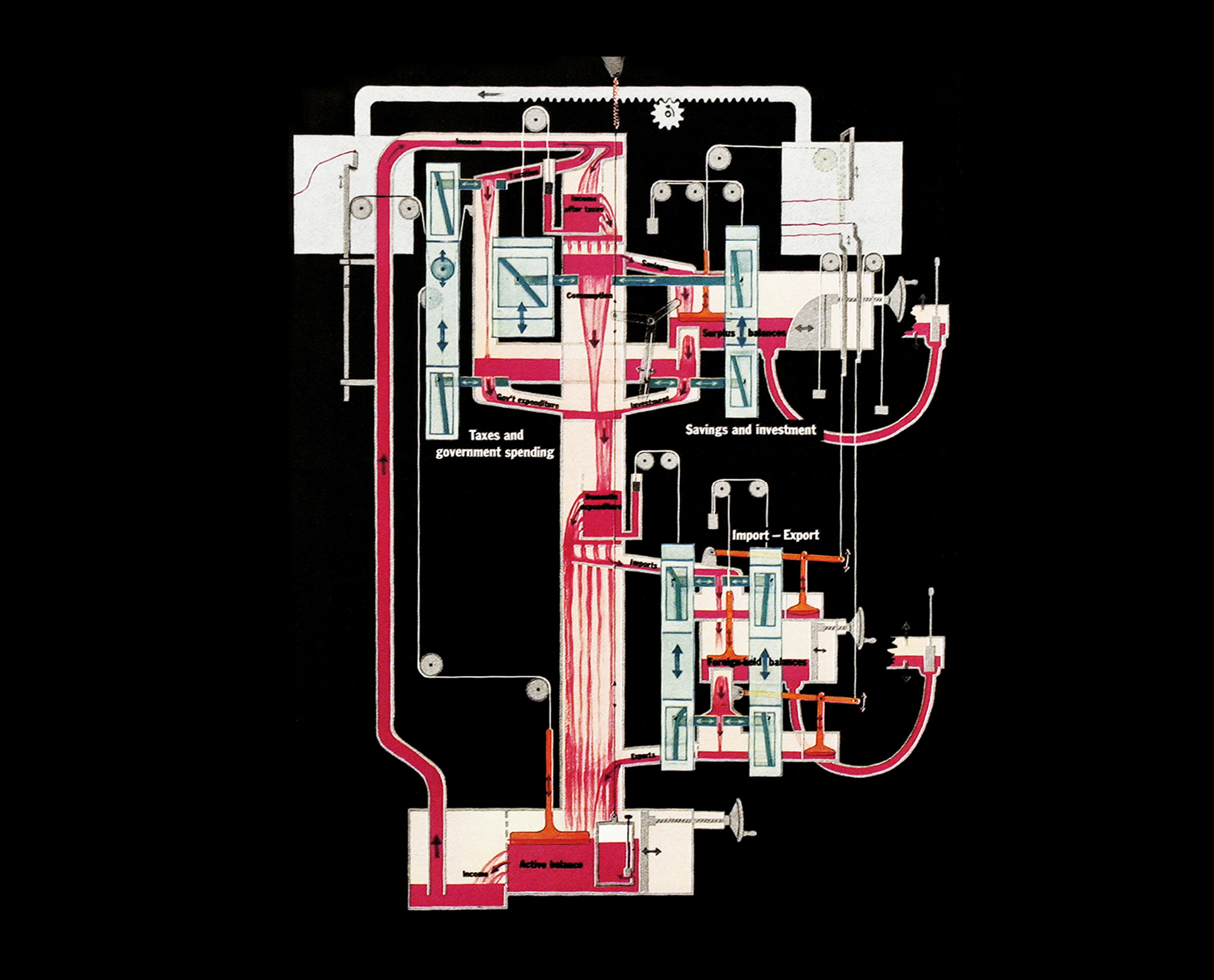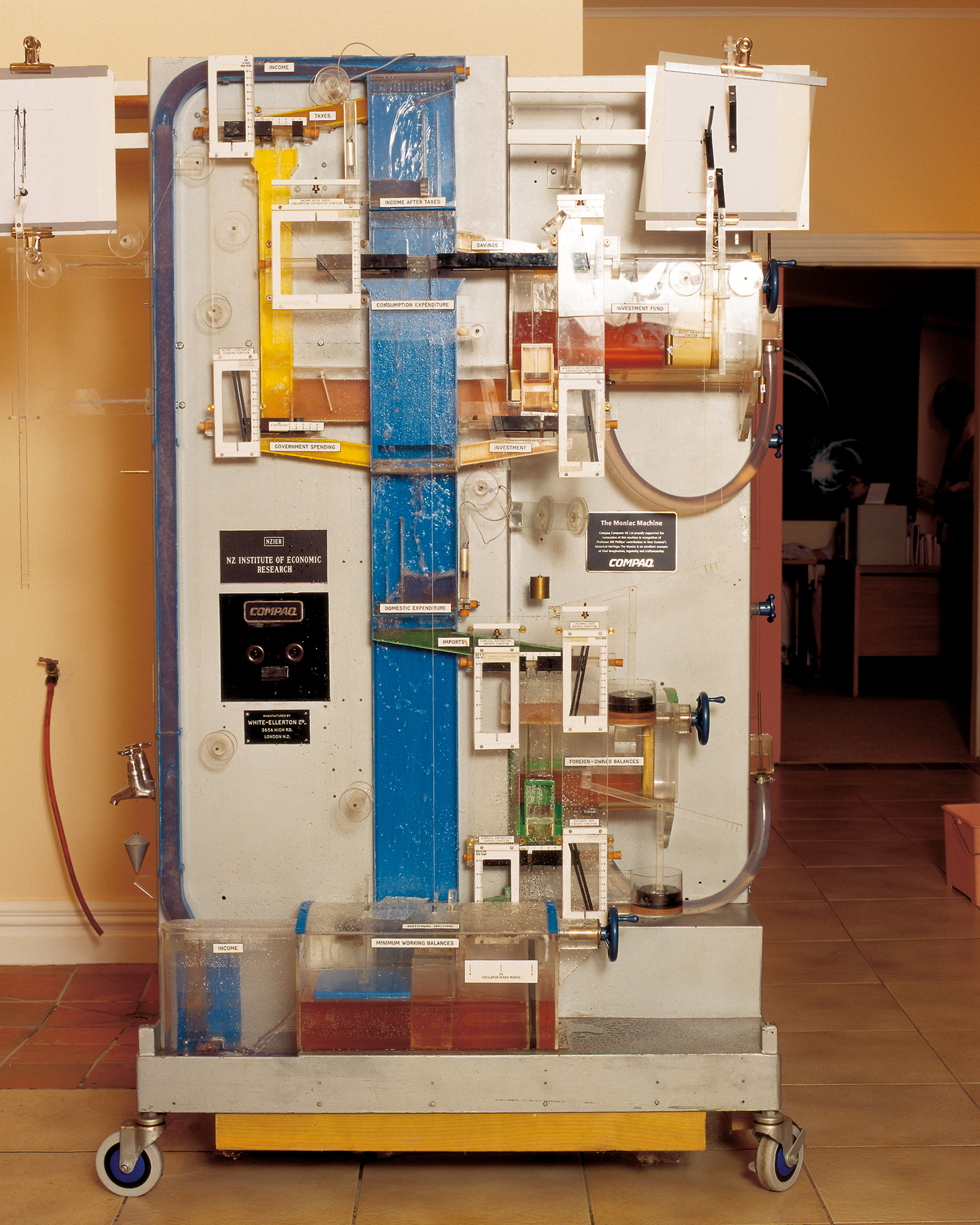Fluid Assets
The economic waterworks of the MONIAC
Will Wiles

On 29 November 1949, some of the most eminent economists of the twentieth century gathered in a room at the London School of Economics (LSE) to watch a machine. Among those present were Sir Lionel Robbins, then head of the LSE’s economics department, as well as prominent figures like Friedrich Hayek, Ronald Coase, and Amartya Sen, but the machine also drew a substantial crowd who had simply come to laugh at it. The machine had been built by Bill Phillips, an LSE sociology undergraduate, in his landlord’s garage in the south London suburb of Croydon. It was a bizarre and chaotic assemblage of pipes, valves, tanks, and gauges standing the height of a man, mostly in transparent Perspex. Pink water was circulating through the contraption. This, Phillips explained, was the Phillips Hydraulic Computer, a working model of the British economy. The pink water represented money, while the various controls represented different variables such as bank rates, taxation, and government spending.
No one laughed. The machine was a hit; the audience was wowed. Phillips and his collaborator Walter Newlyn were granted £700, then a substantial sum of money, to develop a full-scale model based on his prototype. What he built would become one of the most influential devices in economics, and an unusual side-note in the history of computing.
Bill Phillips—considered a genius by his peers and colleagues—could have excelled at any number of professions, and it’s perhaps surprising that he ended up making his greatest contribution in the field of macroeconomics. Phillips was born in Te Rehunga in rural New Zealand in November 1914. Resourcefulness ran in his genes: his father had partially electrified the family’s dairy farm using a hydroelectric generator. Young Bill was inventive from the start, rigging up a rack on the handlebars of his bicycle so he could read while riding, and building, among other things, a zoetrope, a mechanical shooting gallery, a magic lantern, and a crystal radio. Fascinated by the Far East, he decided to visit China after training as an electrician, and boarded a ship to Shanghai. It was 1937, a bad time to make the trip: while Phillips was at sea, Japan declared war on China, and his ship was diverted to Yokohama. Undeterred, Phillips toured Japan instead and afterward, rather than returning home, went to Europe—the hard way. He traveled up through Korea and Manchuria to the Soviet Union and caught the Trans-Siberian Railway west, traveling through Poland and Germany in the last months of European peace.

Reaching London, he graduated from the Institution of Electrical Engineers. Upon the outbreak of World War II, he enlisted in the Royal Air Force and was sent to Singapore. When the island fell to the Japanese in 1942, Phillips managed to escape on the Empire Star, the last merchant ship out of the port. The Empire Star was attacked and, in the heat of battle, Phillips was able to improvise mountings for machine guns on the deck of the ship, allowing the crew to return fire. For this act of heroism, he was later honored with an MBE. Damaged, the Empire Star made it to Java, where Phillips and some comrades again managed to evade the Japanese and set up a secret camp on the south coast of the island. They were captured while trying to adapt the body of a bus into a boat that would carry them to Australia.
Phillips was interned at Bandura. The camp was brutal, and the prisoners frequently beaten, but Phillips still built and invented, risking torture or summary execution to improve the lives of the other prisoners. He built a number of crystal radios, hidden in different places such as a clog and under the kitchen floor, which allowed the camp inmates to hear news from the outside world. In one exploit, he—along with the writer Laurens van der Post—broke into the camp commander’s quarters to pillage his radiogram for parts. He also built simple electrical immersion heaters which internees could use to heat water for tea.
After the war, Phillips returned to London and abandoned electrical engineering for sociology. But he never stopped working with machines—anecdotes later told by his friends typically had him fixing a washing machine, a thermostat, or a radio. “He never complained about a difficulty,” remembered James Meade, an LSE professor who knew Phillips during his time at the school. “He just worked out how to put it right and then proceeded to do so.” It was during his sociology studies that Phillips hit on the idea of building a hydraulic model of the British economy. Robbins recalled being accosted in the lobby of the LSE by “a wild man from New Zealand waving blueprints in one hand and queer-shaped pieces of Perspex in the other.” Gamely, he put Phillips in touch with the mechanically minded Meade, who was able to scrape together some money for the endeavor.
The computer was at heart a waterfall. The water—dyed pink with cochineal to aid visibility—was pumped to the top and cascaded down through a central channel. This represented the national income, all money generated by the economy. Portions of the flow were then diverted into other systems of tanks—taxation was subtracted first, sluicing into a system representing government spending, then savings, imports, and so on. Exports, investments, and government spending rejoined the main falls. A reservoir at the bottom gathered the proceeds and pumped national income back to the top. A second computer, representing the world economy, was linked to it. So the economic cycle ran. Some variables, such as government spending and bank rates, could be controlled by the user; others were interlinked by internal systems of floats and pulleys. Plotters charted results on graph paper.
The prototype was complicated and peculiar, not to mention an unfortunate visual metaphor for the terrible state of the war-worn British economy. If further symbolism was needed, it was built out of surplus war materials: the Perspex came from the windshields of Lancaster bombers, the electric motor from a plane’s windshield wiper. But, unlike the economy, it worked brilliantly. Nine differential equations were represented in the interrelation of its various internal systems. None of these were beyond the computing equipment available at the time, but Phillips’s intention wasn’t calculation—it was exposition. The important feature of the machine was not that the equations were solved, but that the users could see and immediately understand what was going on. It was what is now called a graphical user interface, one pre-dating the age of the screen and far easier to grasp than columns of numbers and fistfuls of punched tape. The workings of the economy and the results of different policies could be demonstrated to an audience, as Phillips had shown, and the machine became a popular teaching aid. A favorite demonstration was to make one student the governor of the Bank of England and another the Chancellor of the Exchequer, giving each control over their respective part of the economy and setting them the same national income target but without allowing them to coordinate their actions. This always led to calamity.
The LSE didn’t just build a Phillips computer for itself—it went into business selling them. A dozen were sold for £1,500 each, approximately £40,000 in today’s prices. Buyers included a number of British universities, Harvard University, the Central Bank of Guatemala, and the Ford Motor Company. For the American market, the machine was called the MONIAC, a name that evoked both money and the ENIAC and MANIAC electronic computers at the University of Pennsylvania and Los Alamos Scientific Laboratory, respectively.
For all its popularity, the Phillips computer had some serious weaknesses. It was “hard-wired” (an inapt term given the lack of wires, unless fishing line is counted) for the British economy as it stood in 1949, and different conditions would require a wholly new device. And Phillips was unhappy that the machine had no way of taking aggregate prices and inflation into account. His attempt to fix this fault led to distinctive new problems. “[He] had drilled a hole in one of the tubes through which water squirted whenever there was an inflation,” wrote Graeme Dorrance in his reminiscences of Phillips. “Regularly, Alan [Day] and I returned to the room to find it a pool. We borrowed some towels from the refectory and wrung them out through the window.” Leaks and spills were not a rare occurrence. Other colleagues recalled pink waterfalls down the stairs of the Department of Applied Economics. “Phillips was repeatedly called away to repair an incontinent machine which had disgraced itself during a class,” wrote Doron Swade, who as senior curator of computing and information technology led the effort to restore the original LSE Phillips machine in 1995.
The pink water in MONIAC’s veins represented the high tide of the use of physical models to understand economics, before the field began its advance into the abstract realm of pure mathematics and game theory. But the machine’s leaky, analogue idiosyncrasies might have made it a better teacher than a more efficient device. It felt profoundly British. There was the natural eccentricity of it, from its bricolage construction to the toolshed charm of its internal waterworks. Its apparently ramshackle and sometime petulant nature also suited the pervasive idea of the British economy, a similarity that drew the eye of the Punch cartoonist Emett, who re-imagined the machine (and the economy) as a teetering contraption driven by a civil servant on a treadmill and recirculating cold tea. Water—which dribbles away, evaporates into nothing, and runs naturally downhill—was also an appropriate economic idiom for a nation fearing that it was stuck in permanent, inevitable decline. And the spills and leaks of the MONIAC were a useful reminder of the inexact nature of economics. Swade, the computer’s restorer, wrote: “It may be that the machine, like the economy, is defying our efforts at control, by flaunting the irregularity of its ways, and giving us a cold shower in the process.”
Robert Leeson, ed., A. W. H. Phillips: Collected Works in Contemporary Perspective (Cambridge: Cambridge University Press, 2000). Typographical errors in the original corrected in quotations used here.
Alan E. Bollard, “Man, Money and Machines: The Contributions of A. W. Phillips” Economica, vol. 78, no. 309 (January 2011), pp. 1–9.
Doron Swade, “The Phillips Economic Computer,” Computer Resurrection: The Bulletin of the Computer Conservation Society, no. 12 (Summer 1995). Available at cs.man.ac.uk/CCS/res/res12.htm#e [link defunct—Eds.].
“A. W. H. Phillips, MBE: Sibling Memories, Press Cuttings, Selected Biographical Notes.” Available at rbnzmuseum.govt.nz/pdf/activities/moniac/theinventor/CarolSomervellMemoirs.pdf.
Will Wiles is an author and an architecture and design journalist. His first novel, Care of Wooden Floors, is published in the US by Amazon / New Harvest.
Spotted an error? Email us at corrections at cabinetmagazine dot org.
If you’ve enjoyed the free articles that we offer on our site, please consider subscribing to our nonprofit magazine. You get twelve online issues and unlimited access to all our archives.